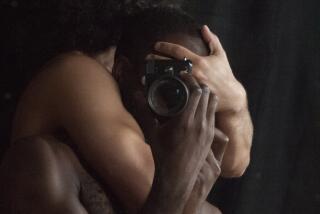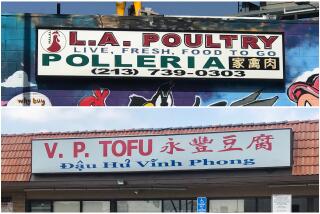A Skewed Image of Latino L.A.?
- Share via
Camilo Jose Vergara’s photographs had never been picketed before. His latest exhibit, about Latinos in Los Angeles, received a positive review in Washington, D.C., and an even better one in New York City. So when a group of artists, urban planners and architects here challenged the accuracy of his presentation, he wondered why.
Maybe, critics suggest, the problem with the exhibit, “El Nuevo Mundo” or “The New World,” is that the barrios of east and South-Central Los Angeles are much more complex than the exhibit’s emphasis on poverty and street life.
Maybe “The Landscape of Latino Los Angeles,” the subtitle of the exhibit now at the Natural History Museum of Los Angeles County, is too broad a term to accurately describe a population that has both deep and shallow roots in the city.
Or maybe the presentation’s focus on the exotic nature of the newest immigrants, which the photographer sees as examples of people thriving in their own way, is a touchy issue in a city self-conscious about race and immigration.
And maybe the barrios that Vergara began photographing in 1992 have been studied by other local artists, urban planners and sociologists who have come to different conclusions about the communities where some of them were born.
Such questions have come mainly from one group: the Latino Urban Forum, an organization of four dozen or so people who mounted an almost-immediate protest.
The museum says the response from the general public has been mostly favorable and many have written diverse observations in several guest books:
“A work from the heart. It brought me joy, sadness and all types of . . . feelings,” wrote one guest.
“Your work, while interesting and ‘artistic,’ portrays Latinos in a one-sided manner,” wrote another. “As an educator, I see my students’ self-esteem leave them. . . . Your exhibit has contributed to this and the negative portrayal of Latinos.”
Exploring the Landscape of L.A.
The exhibit is composed of 107 photographs of the landscape in East and South-Central L.A. inhabited by immigrants from Mexico and Central America. The images range from a dead pit bull in an alley--the victim of what the exhibit caption says are common “clandestine dogfights” in the community--to humble storefront businesses with hand-drawn signs. One photo shows swarms of pedestrians in a downtown business district dominated by immigrants that the exhibit calls, together with other parts of “El Nuevo Mundo,” Little Mexico.
There are also photographs of backyards, one filled with junk, another with farm animals and another that has become a construction site. Vergara has documented homes where residents have modestly personalized original wooden bungalows, an arrest scene, a church behind security bars, homeless people who have taken over a sidewalk. The photographs also drift south to show barriers at the Mexico/U.S border.
“The exhibit was never meant to describe the entire Latino population,” Vergara said, expressing admiration for new immigrants’ attempts to survive and to revitalize parts of the city that might otherwise be abandoned--an upbeat theme that critics say doesn’t come across in the exhibit.
“My interest has always been the poor fellow, how they make it, how they get through life without speaking the language.”
Vergara, 54, was born in Chile and has been a longtime resident of New York City. Most of his work has focused on what he describes as “hellholes,” desolate neighborhoods in such places as Detroit, north Philadelphia and New York City. His work has been shown widely, including at the Getty Center, the Smithsonian Institution, the New York Public Library and the National Building Museum in Washington, D.C.
Just as his last book, “The New American Ghetto” (Rutgers University Press, 1995), was the result of his research on urban decay, he intends to write a book based on his research in Los Angeles.
Vergara came to Los Angeles in 1992 to photograph what he thought would be African American communities. But he said he found the areas inhabited by new immigrants who function in a technologically humble world, creating their own jobs that sometimes are as simple as selling fruit on the streets in one of the most sophisticated cities in the world.
He didn’t find the mosaic of races and the melting pot often associated with Los Angeles, he says. Instead, he says he found a large Spanish-speaking population where signs of assimilation weren’t evident.
‘Layering of Latino Cultures’
The museum’s brochure reads: “ . . . color photographs showing the changing physical character and the layering of Latino cultures in Los Angeles County. His work explores how Latinos build and decorate their homes, landscape their yards and revitalize their neighborhoods to resemble the warmth and vibrancy of those in Mexico and Central America.”
His critics’ primary criticism is what they perceive as the exhibit’s overgeneralizations.
Vergara said the text makes clear the people in question are poor immigrants in East and South-Central Los Angeles. But the introduction to the exhibit cites general population numbers for the county: 9.5 million people, 41% of whom are Latino. Critics fear that would cause an East Coast audience to assume that the exhibit portrayed all Latinos in Los Angeles.
Critics also question whether the exhibit accurately describes those neighborhoods or goes out of its way to show their worst elements.
In Vergara’s photographs, “I just saw one side of what our community is,” said Pablo Aguilar, 30, a member of the Urban Latino Forum who has photographed some of the same neighborhoods.
Some say they wish Vergara had shown not only the barrios of East and South Central but also the middle-class neighborhoods. For example, Vergara does include photos of modestly decorated homes, but other researchers like urban planner James Rojas, who is spearheading the protest, have written about elaborate improvements in the areas such as wrought-iron gates and well-tended yards featuring rose gardens.
Rojas’ studies particularly focused on how the people’s use of public space creates a positive social environment that might seem chaotic to someone who doesn’t understand the neighborhood.
“People raise chickens, but that’s not the majority of the people,” said Raul Escobedo of Barrio Planners, an Eastside architectural firm. “He went out of his way to show situations that are not typical. People in Boyle Heights can put that into perspective. The concern is what people [who don’t know the neighborhood] derive when they only see those images.”
Art or an Analysis?
A key question has been whether the exhibit is one man’s artistic interpretation or an analytical statement.
If Vergara intends his photographs to be viewed as art, his artistic expression would not be opposed, said Leda Ramos, director of technology and education at the Central American Resource Center and a Latino forum member, adding that the exhibit might be more appropriate in an art gallery.
But the group complains that the exhibit appears to be scientific, given the nature of the museum and the description of Vergara as guest curator and sociologist. If the exhibit is intended as a documentary, they say, it should be presented in the proper context, subjected to peer review, with a listing of sources.
“I’m sure when the museum gets dinosaur bones, they need some validation to make sure these are not cow bones,” Rojas said.
Vergara, who has an undergraduate degree in sociology from University of Notre Dame, describes himself as both an artist and social scientist--and the exhibit as his own interpretation.
The presentation is intended to be a cultural one, said James Powell, president and director of the museum.
“It should attract interest, and a little controversy is not a bad thing,” he said. “We are very proud of the exhibit, and it has served a useful purpose.”
In addition to the regular exhibit review committee that selected Vergara’s photographs, the museum convened a special panel anchored by museum trustee Julio Ramirez to give the photographs an additional review. Both panels, Powell said, recognized that the exhibit might be controversial but that it did not intend to represent an “encyclopedic representation of Latino culture and contributions in Los Angeles.”
The museum welcomed the Latino forum’s early protest, but Powell has said that the forum’s subsequent request for a public discussion of the exhibit would be better handled by USC, because its Southern California Studies Center was an exhibit co-sponsor.
Powell said the museum’s philosophy is to continue to show slices of American life--emphasizing that “El Nuevo Mundo” is merely one slice. Next spring the museum will present “Americanos: Latino Life in the United States,” which he said probably will be seen as a more comprehensive and sympathetic exhibit.
“I think over time it would be a legitimate question: Has the museum presented an accurate view of this group?” Powell said.
* “El Nuevo Mundo: The Landscape of Latino Los Angeles,” on display through July 16 at Natural History Museum, 900 Exposition Blvd., L.A. Open seven days, 10 a.m. to 5 p.m. Admission, $8 adults, $5.50 seniors, $2 children. Museum information: (213) 763-3466.
* Jose Cardenas can be reached at [email protected].
More to Read
The biggest entertainment stories
Get our big stories about Hollywood, film, television, music, arts, culture and more right in your inbox as soon as they publish.
You may occasionally receive promotional content from the Los Angeles Times.










